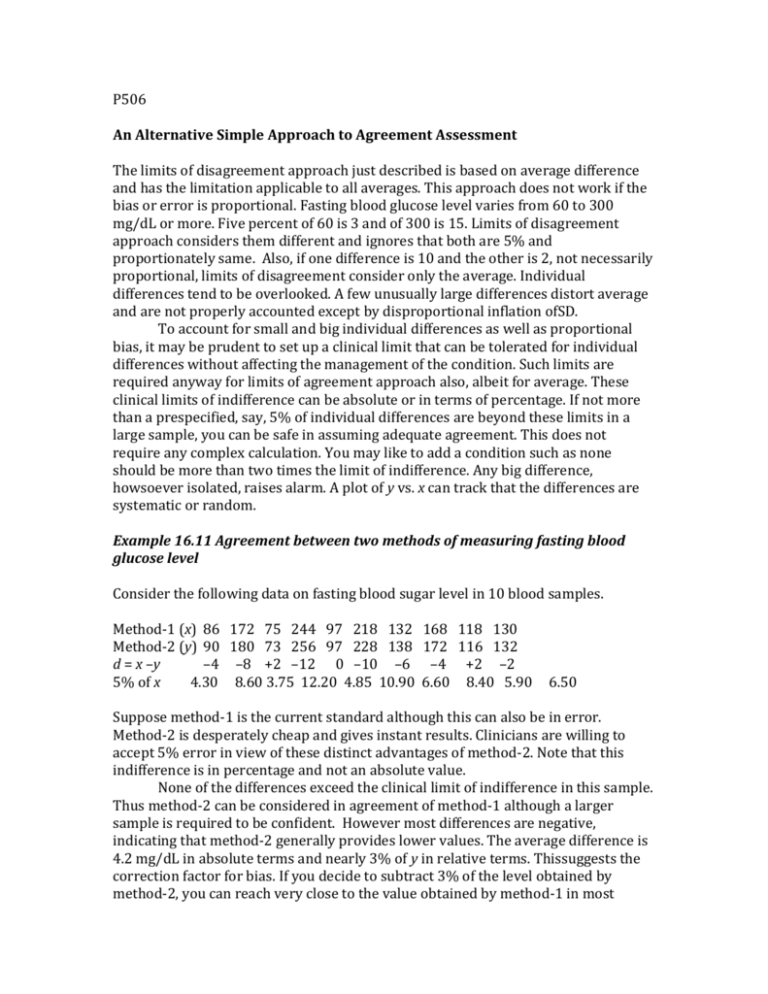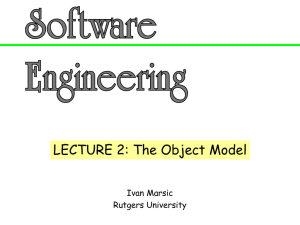25. An alternative approach for assessing agreement
advertisement

P506 An Alternative Simple Approach to Agreement Assessment The limits of disagreement approach just described is based on average difference and has the limitation applicable to all averages. This approach does not work if the bias or error is proportional. Fasting blood glucose level varies from 60 to 300 mg/dL or more. Five percent of 60 is 3 and of 300 is 15. Limits of disagreement approach considers them different and ignores that both are 5% and proportionately same. Also, if one difference is 10 and the other is 2, not necessarily proportional, limits of disagreement consider only the average. Individual differences tend to be overlooked. A few unusually large differences distort average and are not properly accounted except by disproportional inflation ofSD. To account for small and big individual differences as well as proportional bias, it may be prudent to set up a clinical limit that can be tolerated for individual differences without affecting the management of the condition. Such limits are required anyway for limits of agreement approach also, albeit for average. These clinical limits of indifference can be absolute or in terms of percentage. If not more than a prespecified, say, 5% of individual differences are beyond these limits in a large sample, you can be safe in assuming adequate agreement. This does not require any complex calculation. You may like to add a condition such as none should be more than two times the limit of indifference. Any big difference, howsoever isolated, raises alarm. A plot of y vs. x can track that the differences are systematic or random. Example 16.11 Agreement between two methods of measuring fasting blood glucose level Consider the following data on fasting blood sugar level in 10 blood samples. Method-1 (x) 86 172 75 244 97 218 132 168 118 130 Method-2 (y) 90 180 73 256 97 228 138 172 116 132 d = x –y –4 –8 +2 –12 0 –10 –6 –4 +2 –2 5% of x 4.30 8.60 3.75 12.20 4.85 10.90 6.60 8.40 5.90 6.50 Suppose method-1 is the current standard although this can also be in error. Method-2 is desperately cheap and gives instant results. Clinicians are willing to accept 5% error in view of these distinct advantages of method-2. Note that this indifference is in percentage and not an absolute value. None of the differences exceed the clinical limit of indifference in this sample. Thus method-2 can be considered in agreement of method-1 although a larger sample is required to be confident. However most differences are negative, indicating that method-2 generally provides lower values. The average difference is 4.2 mg/dL in absolute terms and nearly 3% of y in relative terms. Thissuggests the correction factor for bias. If you decide to subtract 3% of the level obtained by method-2, you can reach very close to the value obtained by method-1 in most cases. Do this as an exercise and verify yourself.Note that all this does not require any calculation such as mean and SD. Now forget about 5% tolerance, and note that some differences are small and some are quite large. Since sd = 2.80 in this case, the limits of disagreement are –4.2 ± 2×2.80, or –9.8 to +1.4. These limits may look too wide and beyond clinical tolerance, particularly on the negative side. These limits do not allow larger error for larger values that proportionate considerations would allow. Also, these are based on average and do not adequately consider individual differences. If one out of 20 values shows a big difference, this can distort the mean and inflate the SD, and provide unrealistic limits of disagreement. The alternative approach suggested above can be geared to allow not more than 5% individual differences beyond tolerance limit and you can impose an additional condition that none should exceed, say, by 10% of the base value. Since based on individual differences and not average, this alternative approach may be more appealing too.







